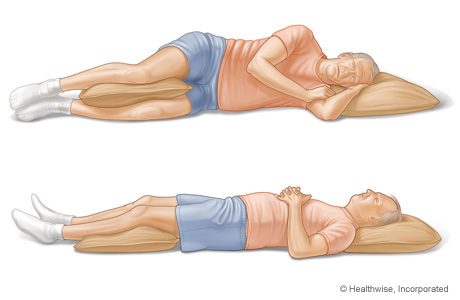Good Posture for a Healthy Back
Overview

Good posture helps protect your back when you sit, stand, and walk. Good posture means your ears, shoulders, and hips are in a straight line, with your spine in three front-to-back curves that give it an "S" shape. These curves help absorb stress and impact on your back.
Sitting with good
posture
To protect your back, pay attention to your posture when you sit.
Do not sit for long periods. Take regular breaks to walk around and stretch.
Standing with good
posture
The following tips may help you have good posture when you are standing.
- Keep your ear, shoulder, hip, and ankle in a line.
- Avoid locking your knees while standing.
Try placing one foot on a low stool if you must stand in one position for a long time, such as when you wash dishes or do other tasks. Switch feet every few minutes.
- Keep your lower back in the neutral position.
A healthy back has three natural front-to-back curves that give the spine an "S" shape. Too much curve (swayback) or too little curve (flat back) can cause problems. The right amount of curve is called the neutral position.
Walking with good
posture
Walking is one of the best things you can do for your back. You may find that your back hurts less when you walk. But if you're concerned about any back pain you have while walking, talk to your doctor.
- Keep good posture as you walk.
This generally means that your ears, shoulders, and hips are in a straight line.
- Keep your head up and your eyes forward.
- Every once in a while, shrug your shoulders and then relax them.
This will remind you not to keep your shoulders tense as you walk.
Comfortable sleeping
positions

To be more comfortable while you sleep, support your body so that you don't twist your back.
- If you sleep on your side, place a pillow between your knees. This keeps your top leg from falling over your bottom leg and twisting your back. You also can put a small, rolled-up towel under your waist.
- If you sleep on your back, place a pillow under your knees. You also can put a small, rolled-up towel under the curve of your back.
Many people find that these sleeping positions work for them, but they may not work for you. Find the position that helps you the most. If you have a very soft mattress, you may find that switching to a firmer one is more comfortable for your back.
Credits
Current as of: July 24, 2025
Current as of: July 24, 2025